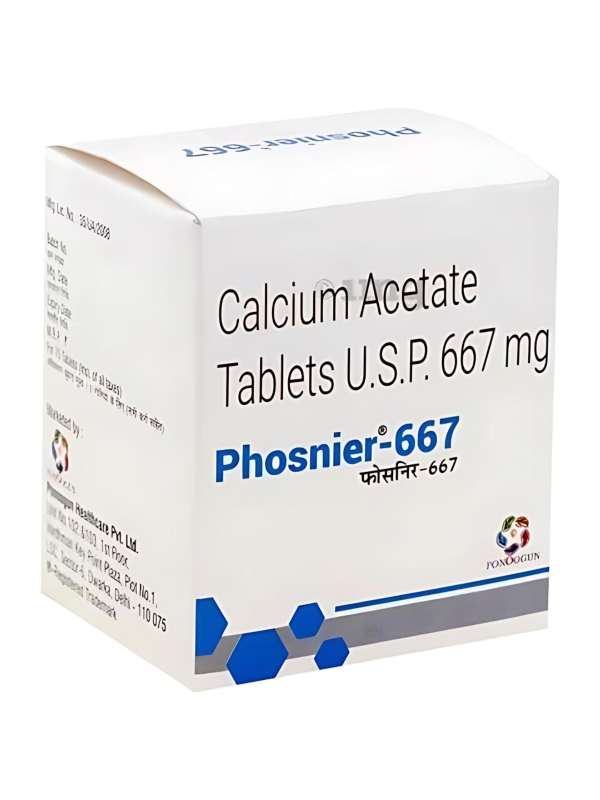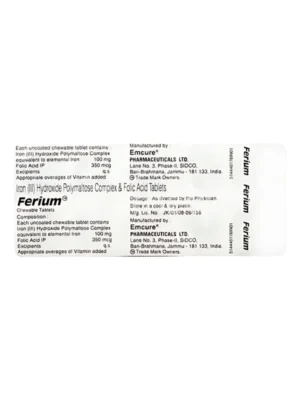Description
Phosnier 667 Tablet – Effective Phosphate Binder for Dialysis Patients
Phosnier 667 Tablet is a phosphate-binding medication used to manage high phosphate levels (hyperphosphatemia) in the blood, especially in patients with chronic kidney disease (CKD) undergoing dialysis. It contains Calcium Acetate, which helps remove excess phosphate by binding to it in the digestive tract, preventing its absorption into the bloodstream.
Key Benefits:
- Reduces high phosphate levels in patients with kidney failure
- Helps prevent complications like bone pain, itchy skin, and vascular calcification caused by elevated phosphate
- Supports phosphate management during hemodialysis or peritoneal dialysis
Uses of Phosnier 667 Tablet:
How Phosnier 667 Tablet Works?
Phosnier 667 Tablet contains Calcium Acetate, a compound that binds to dietary phosphate in the stomach. The resulting calcium phosphate compound is excreted through the intestines, effectively reducing phosphate absorption and lowering serum phosphate levels.
How to Use?
- Take Phosnier 667 Tablet with meals to maximize phosphate binding
- Swallow the tablet whole with water—do not chew, crush, or break
- Take it at the same time daily, as prescribed by your healthcare provider
Missed Dose?
If you miss a dose, take it as soon as you remember. If it’s almost time for your next dose, skip the missed one and return to your regular schedule. Do not double the dose.
Side Effects of Phosnier 667 Tablet:
Common Side Effects
- Increased calcium levels in the blood (hypercalcemia)
- Nausea
- Diarrhea
Symptoms of High Calcium Levels
- Abdominal pain
- Constipation
- Muscle weakness
- Bone pain
- Lack of energy or fatigue
If you notice these symptoms, contact your doctor for dose adjustment or alternative treatment.
Safety Information:
- Pregnancy: Use only if clearly needed. Discuss risks and benefits with your doctor.
- Breastfeeding: Likely safe with proper monitoring of maternal calcium levels.
- Alcohol: Safety not established. Consult your doctor.
- Driving: Use caution. Effects on concentration are unknown.
- Kidney Disease: Safe in CKD patients on dialysis. No dose adjustment required.
- Liver Disease: Use with caution. Consult your doctor.
Drug Interactions:
- Antacids with Calcium: Avoid concurrent use. Maintain a 2-hour gap.
- Antibiotics: May reduce the absorption of certain oral antibiotics. Discuss timing with your healthcare provider.
Who Should Avoid Phosnier 667 Tablet?
- Patients with high calcium levels (hypercalcemia)
- Patients with known hypersensitivity to calcium acetate or related compounds
Monitoring and Precautions:
- Regular blood tests may be needed to monitor calcium and phosphate levels
- Do not take additional calcium supplements unless advised by your doctor
FAQs:
When should I not take Phosnier 667 Tablet?
Do not use this medication if you already have high blood calcium levels. Always consult your doctor before starting treatment.
Can Phosnier 667 Tablet increase calcium levels?
Yes, it may lead to hypercalcemia. Report symptoms like nausea, constipation, or muscle weakness to your doctor immediately.
Can I take Phosnier 667 Tablet with antacids?
Avoid using calcium-containing antacids at the same time. Leave at least a 2-hour gap between them.
Can I take antibiotics with this medicine?
Phosnier may reduce the effectiveness of certain oral antibiotics. Use them at different times as advised by your doctor.
Can I use Phosnier while breastfeeding?
Yes, but only if prescribed. It is not expected to harm a breastfed infant if maternal calcium levels are monitored.
How can I remember to take my dose?
Use reminders like a pillbox, smartphone alarm, or medication tracking app to avoid missing doses.








There are no reviews yet.